Featured
Why Demand for Cocoa Will only Improve Slightly
New York and London closed lower last week as the weather is generally good for West Africa and Southeast Asia. Ideas are that demand will only improve slightly if at all and production in West Africa appears to be good this year. Both Ivory Coast and Ghana are reporting improved weather as it is now mostly sunny with some scattered showers around.
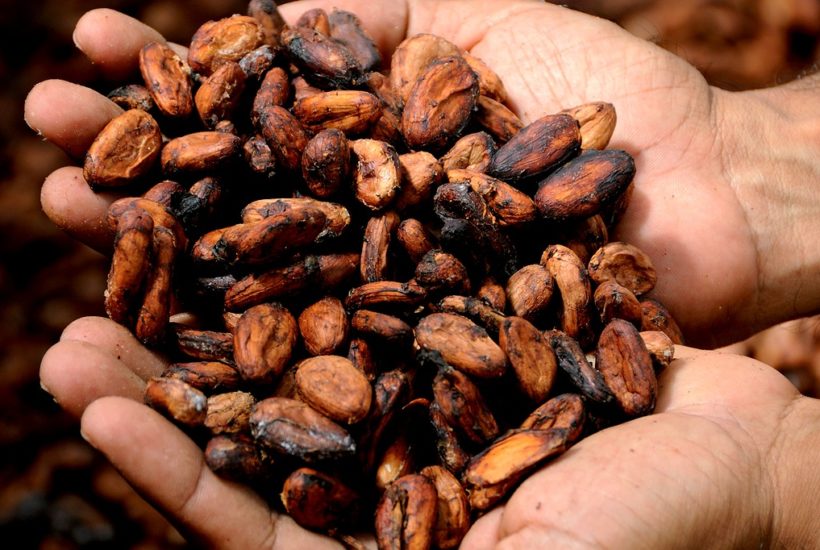
Wheat: Wheat markets closed higher last week on weather concerns as the big wind storm moved through the Great Plains late last week and as warm and dry weather is in the forecast for the Great Plains. Some damage reports have been heard and the wind blew at hurricane force levels and a lot of the soil was blown around and probably shredded the Wheat. The losses could become significant. Ideas have been that the US will have good demand for Wheat as the rest of the northern hemisphere is short production this year but so far demand has been average against previous years. Offer volumes are down in Europe although there has been talk of increased offers from Russia. Dry weather in southern Russia, as well as the US Great Plains and Canadian Prairies, caused a lot less production. The lack of production has reduced the offers and Russia has announced sales quotas for next year. Russia has already increased export taxes to control the flow of export Wheat out of the country and announced last week that a quota of 8 million tons per month would be put on Wheat exports for the foreseeable future. Australia has had too much rain and the crop quality should be diminished, but conditions are drier now and the harvest is moving ahead.
Weekly Chicago Soft Red Winter Wheat Futures

Weekly Chicago Hard Red Winter Wheat Futures
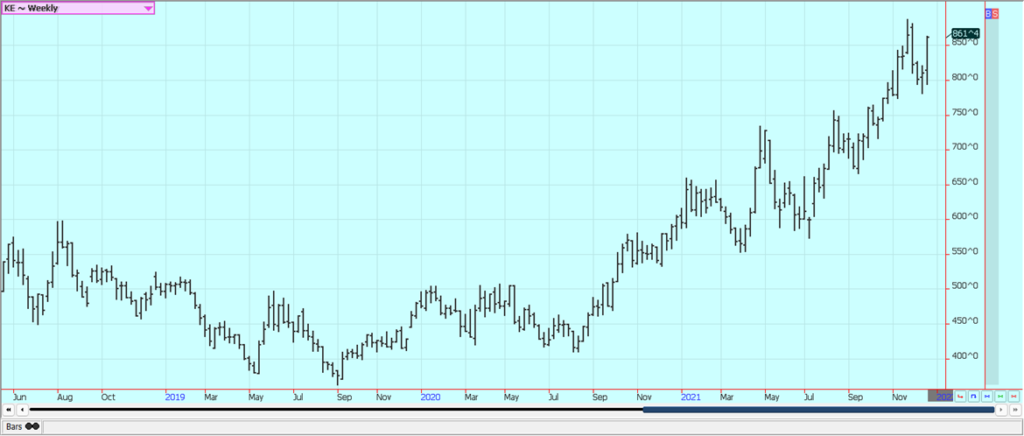
Weekly Minneapolis Hard Red Spring Wheat Futures
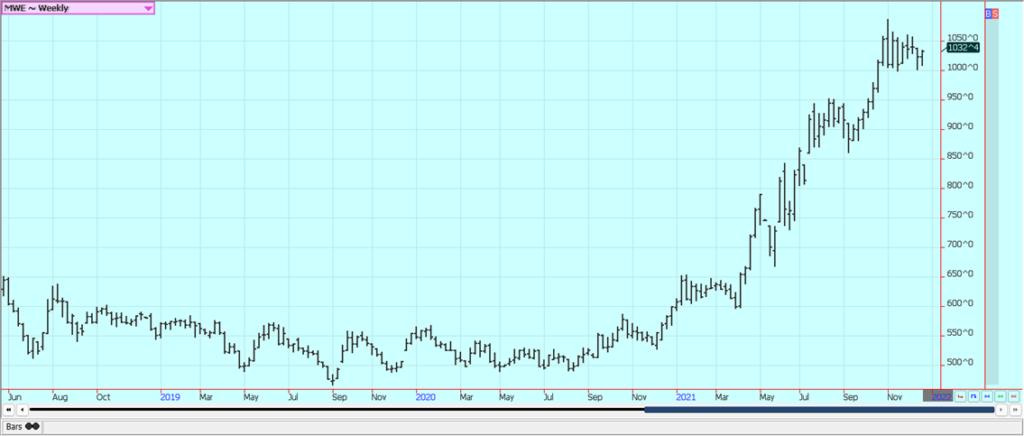
Corn: Corn closed higher again last week and chart trends have turned up. Support came from ideas that the overall fundamental picture for Corn is bullish. Corn has relatively tight supplies as farmers are mostly done harvesting and not selling. Demand has been strong for exports and very strong for Ethanol consumption. Demand will be an increasing feature in the trade moving forward and the strong weekly export sales report was important for the market moving forward. Demand has been good so far this season but a lot of the Chinese business has gone to Ukraine this Fall. That is expected to change over the Winter as Ukraine exportable supplies start to run low. It could change further is Russia invades Ukraine in the future. Interior basis levels are reported to be strong due to strong demand. There are a lot of ideas that production and planted and harvested area will be significantly less next year due to the lack of fertilizers available and the cost of production.
Weekly Corn Futures
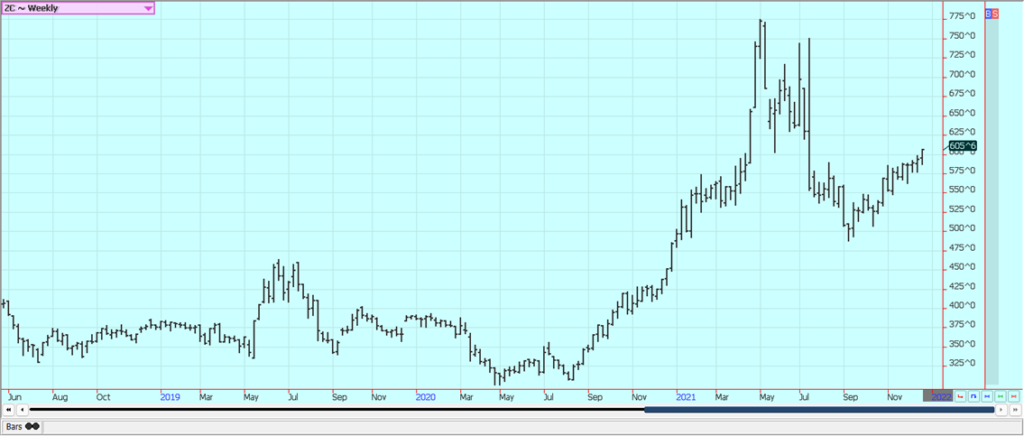
Weekly Oats Futures
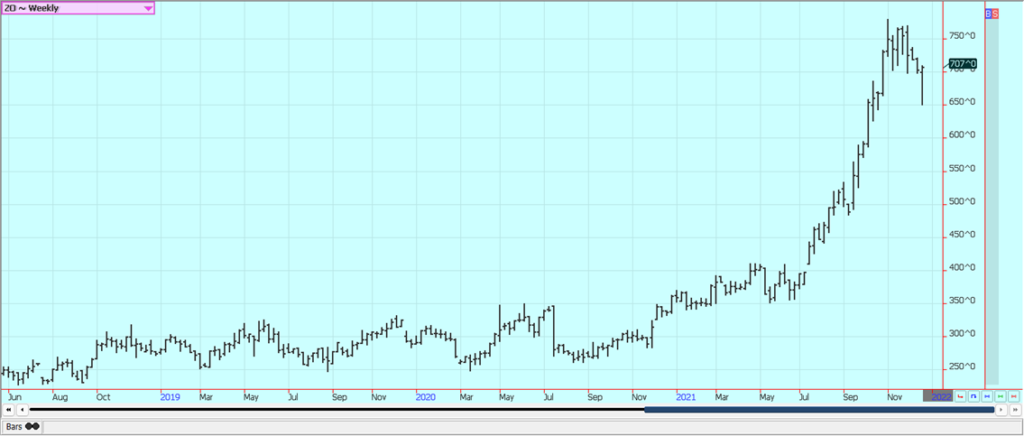
Soybeans and Soybean Meal: Soybeans and both of the products closed higher last week and the trends are turning up on the daily and weekly charts. Soybean Oil trends are sideways. Planting and initial crop development is going very well in central and northern Brazil but it has turned dry in southern Brazil and in parts of Argentina. Drier weather is returning to these areas after some showers in the last week and a dry bias is expected going forward. It is a La Nina year and that implies drier than normal weather in southern Brazil and northern Argentina. Reports indicate that some Corn has been lost and ideas are that Soybeans could become stressed if the dry weather returns. Brazil could have soybeans ready for export by the end of February and the crop potential is up to 150 million tons although many are now starting to drop production outlooks due to the hot and dry weather. Ideas are now that Brazil can produce between 142 and 145 million tons of Soybeans this year due to the losses in the south.
Weekly Chicago Soybeans Futures:
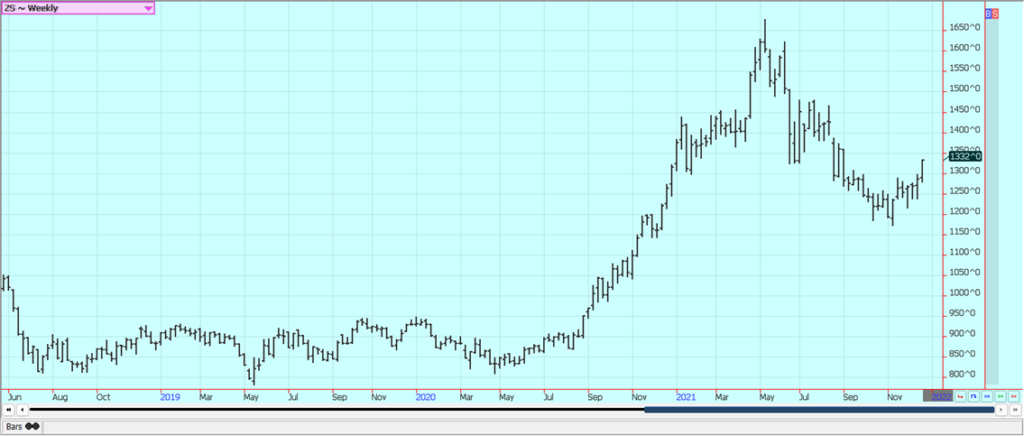
Weekly Chicago Soybean Meal Futures
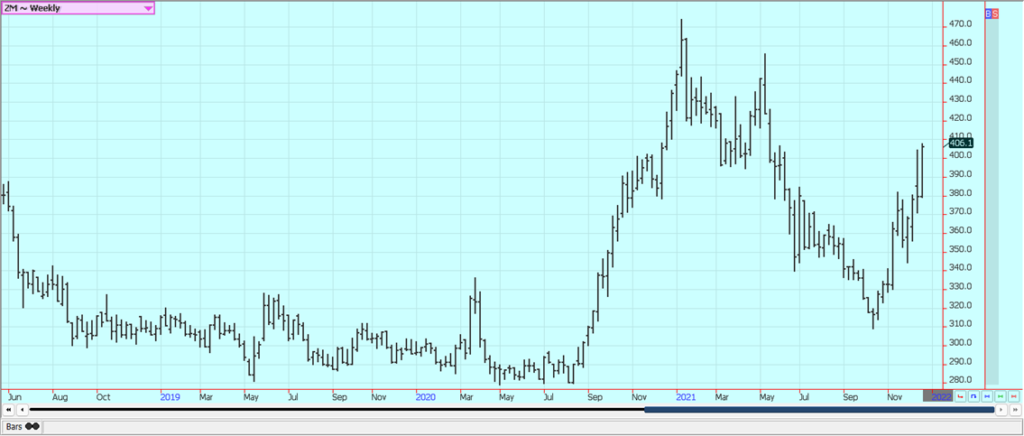
Rice: Rice was higher last week as the speculative selling apparently came to an end. Futures have now moved lower for the last several weeks after making new highs for the move. Futures and cash market trading have gone quiet for the holidays. Many producers are done harvesting and are hunting and not interested in selling at a time that is traditionally the cheapest prices of the year. Mills have already purchased what they need for the holidays as will not show much interest in the market until the first part of the middle of next month. The cash market is reported to be relatively strong as prices have held firm despite the quiet activity.
Weekly Chicago Rice Futures

Palm Oil and Vegetable Oils: Palm Oil was higher last week. India has lowered its import taxes on Palm Oil this week. Traders are mostly worried about India who has been buying Soybean Oil in the US instead of Palm Oil from Malaysia and Indonesia and is also worried about China and its demand for Palm Oil for bio fuels. Support still comes from ideas that supply and demand are in balance or supplies are short. There are ideas of tight supplies due to labor problems. There are just not enough workers in the fields due to Coronavirus restrictions. There have also been reports of flooding in Malaysian palm fields. Production has also been down to more than offset the export losses so prices have trended higher. Canola was mixed to higher on price action in Chicago Soybean Oil. Nearby months were lower on some speculative selling late last week. Farmers are bullish and reluctant to sell because of the sharp reduction in Canola production in Canada this year. The buy-side thinks that Canola is fully priced but the farmers are still holding out for more.
Weekly Malaysian Palm Oil Futures
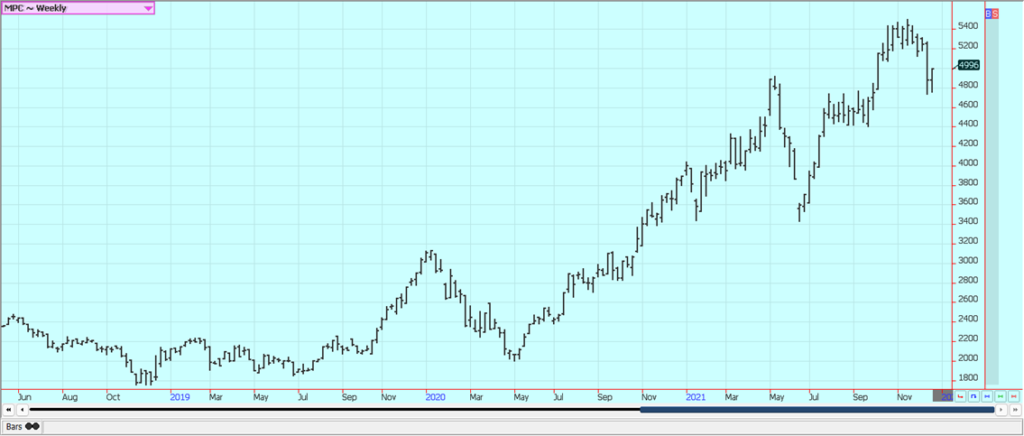
Weekly Chicago Soybean Oil Futures
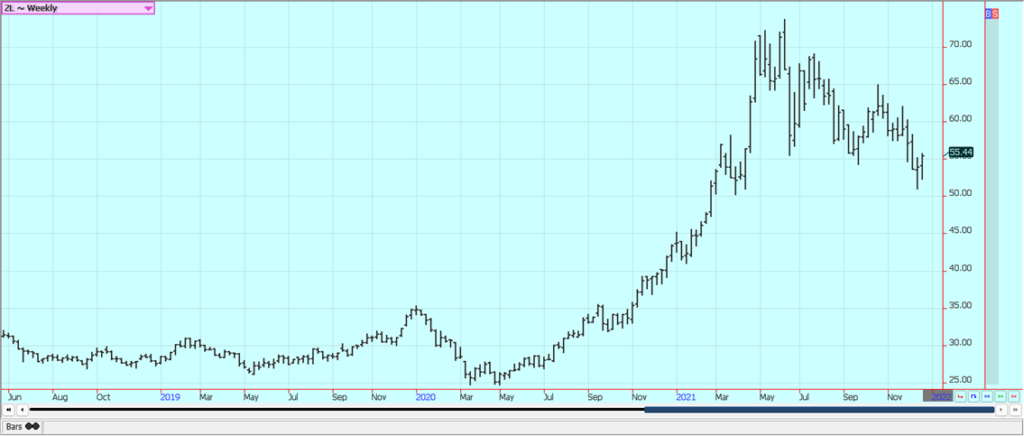
Weekly Canola Futures:
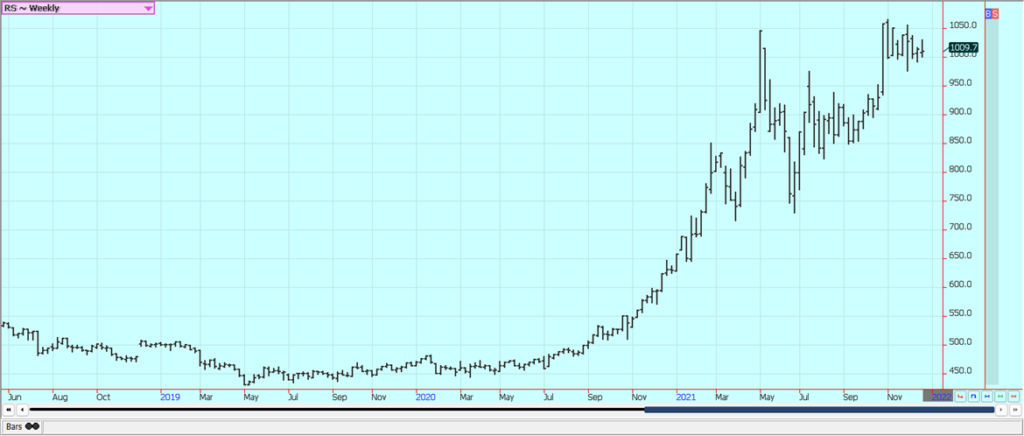
Cotton: Cotton futures closed a little higher again Friday and a little higher for the week on ideas that the economy will be OK even with no Biden economic plan. Ideas are that demand is strong for US Cotton right now. Chart patterns are now mixed. Analysts say the Asian demand is still very strong and likely hold at high levels for the future. US consumer demand has been very strong as well despite higher prices and inflation. Good US production is expected for next year as planted area is expected to increase due to high Cotton prices and the expense of planting Corn.
Weekly US Cotton Futures
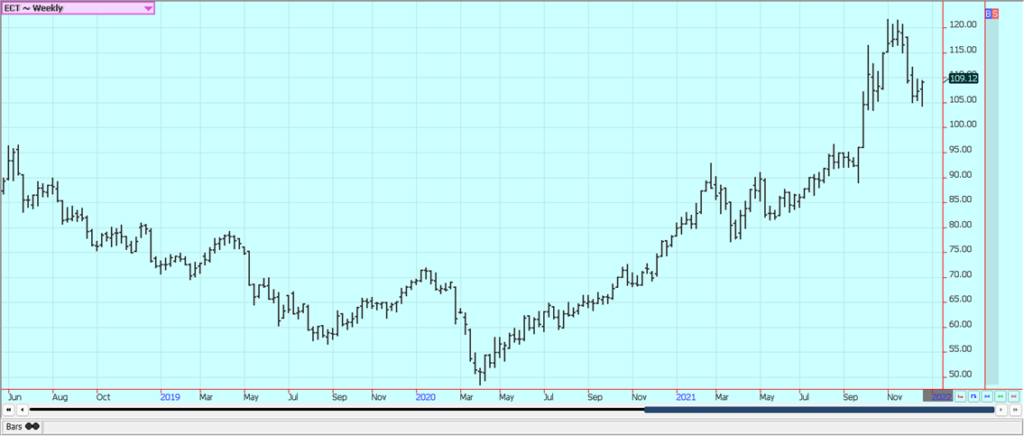
Frozen Concentrated Orange Juice and Citrus: FCOJ was higher again last week and trends remain up on the charts. The weather remains generally good for production around the world. Brazil has some rain and conditions are rated very good. Brazil production was down last year due to dry conditions at flowering time and then a freeze just before harvest. Weather conditions in Florida are rated mostly good for the crops with a couple of showers and warm temperatures. Mexican crop conditions in central and southern areas are called good with rains. Northern and western Mexico is rated in good condition.
Weekly FCOJ Futures
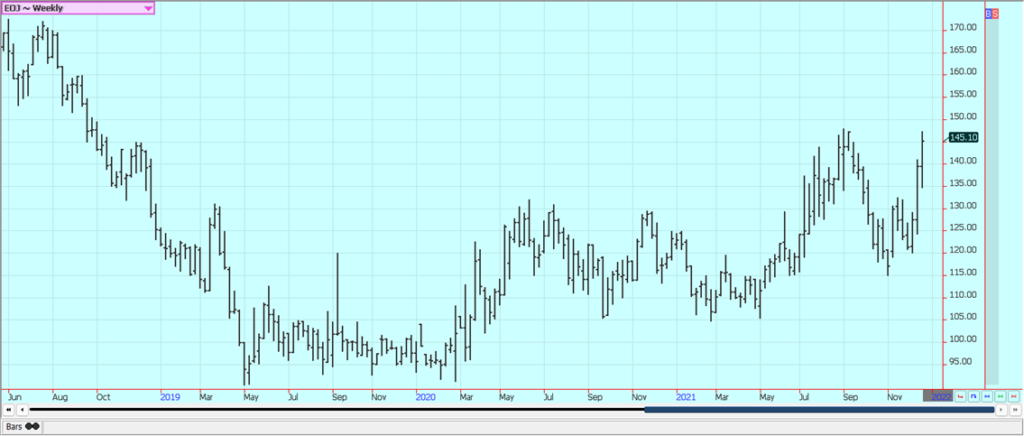
Coffee: New York closed lower last week and London closed higher as the market fundamentals remain important. Damaging weather for Brazil Arabica areas and as the logistical and production problems in Brazil and Vietnam are still around. The dry weather and then the freeze in Brazil have created a lot of problems for the trees to form cherries this year. The lack of Coffee available to deliver against contracts remains a factor and the cheapest Coffee for buyers is often at the exchanges. Containers are not available in Vietnam or in Brazil to ship the Coffee. Cherry pickers are hard to find in Vietnam due to Covid problems. The crop there could be damaged if a storm hits the Coffee while it is drying on the patios this week and showers are in the forecast to at least delay maturity and drying. The rest of Southeast Asia should get scattered showers. Brazil also has limited amounts of Coffee available after bad weather at flowering time and then a freeze before the harvest got underway. Production conditions for the next crop in Colombia are not real good.
Weekly New York Arabica Coffee Futures

Weekly London Robusta Coffee Futures

Sugar: New York and London closed higher again last week on the back of the rallies in the petroleum and financial markets. Mixed trends are showing on the daily and weekly charts. Weaker production ideas in Brazil were seen again. Weaker demand ideas were still being caused by reports of new lockdowns in Europe as the Covid returns there and reports of a new variant discovered in Africa. Some stores and restaurants are closing in the US. However, the effects of the new variant are reported to be mild so the fears were less. Reports indicate that consumer demand has returned to the market. Ideas are that the supplies are out there but it will take a stronger price to get them into the market. Ideas are that Indian producers and exporters are willing sellers above 20.50 cents. Processors in Brazil are refining the cane for Ethanol more than Sugar right now and this trend is expected to continue due to the relative price spreads. The reduced production potential from Brazil for the current harvest is still impacting the market as cane production suffered last season.
Weekly New York World Raw Sugar Futures

Weekly London White Sugar Futures

Cocoa: New York and London closed lower last week as the weather is generally good for West Africa and Southeast Asia. Ideas are that demand will only improve slightly if at all and production in West Africa appears to be good this year. Both Ivory Coast and Ghana are reporting improved weather as it is now mostly sunny with some scattered showers around. Some farmers want more rain for the best Spring harvest results. Cocoa arrivals in Ivory Coast are now 83,000 tons, down 6.4% from last year.
Weekly New York Cocoa Futures
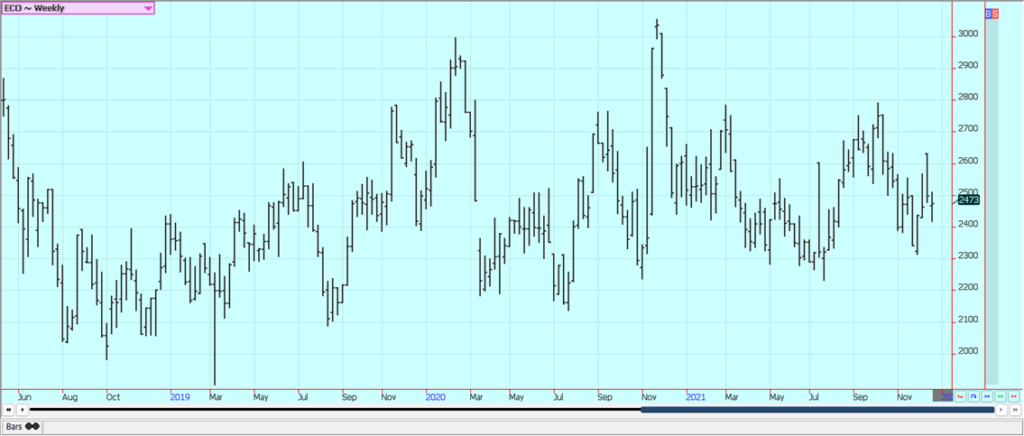
Weekly London Cocoa Futures
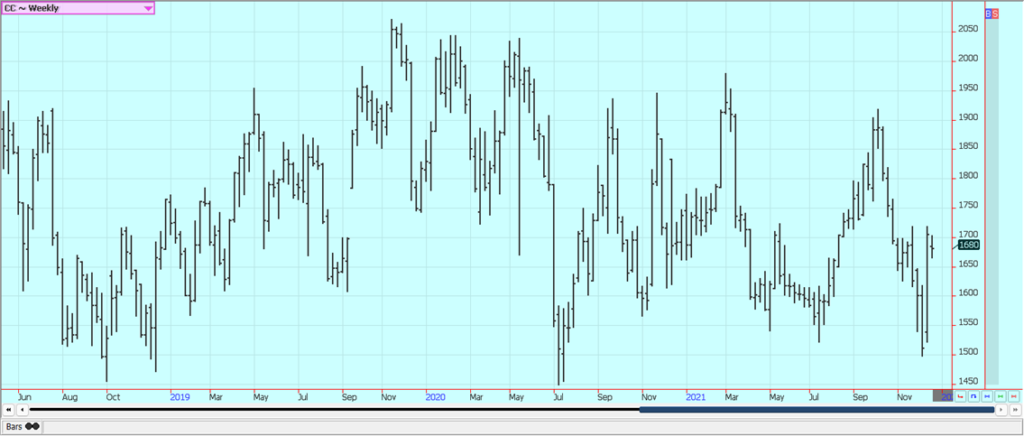
—
(Featured image by 5671698 via Pixabay)
DISCLAIMER: This article was written by a third party contributor and does not reflect the opinion of Born2Invest, its management, staff or its associates. Please review our disclaimer for more information.
This article may include forward-looking statements. These forward-looking statements generally are identified by the words “believe,” “project,” “estimate,” “become,” “plan,” “will,” and similar expressions. These forward-looking statements involve known and unknown risks as well as uncertainties, including those discussed in the following cautionary statements and elsewhere in this article and on this site. Although the Company may believe that its expectations are based on reasonable assumptions, the actual results that the Company may achieve may differ materially from any forward-looking statements, which reflect the opinions of the management of the Company only as of the date hereof. Additionally, please make sure to read these important disclosures.
Futures and options trading involves substantial risk of loss and may not be suitable for everyone. The valuation of futures and options may fluctuate and as a result, clients may lose more than their original investment. In no event should the content of this website be construed as an express or implied promise, guarantee, or implication by or from The PRICE Futures Group, Inc. that you will profit or that losses can or will be limited whatsoever. Past performance is not indicative of future results. Information provided on this report is intended solely for informative purpose and is obtained from sources believed to be reliable. No guarantee of any kind is implied or possible where projections of future conditions are attempted. The leverage created by trading on margin can work against you as well as for you, and losses can exceed your entire investment. Before opening an account and trading, you should seek advice from your advisors as appropriate to ensure that you understand the risks and can withstand the losses.

-

 Fintech5 days ago
Fintech5 days agoMuzinich and Nao Partner to Open Private Credit Fund to Retail Investors
-

 Crowdfunding2 weeks ago
Crowdfunding2 weeks agoSwitzerland’s Crowdfunding Market Remains Stable – Without Growth
-

 Crypto8 hours ago
Crypto8 hours agoBitcoin Traders on DEXs Brace for Downturn Despite Price Rally
-

 Business1 week ago
Business1 week agoDebt-Fueled Markets, Zombie Corporations, and the Coming Reckoning
























